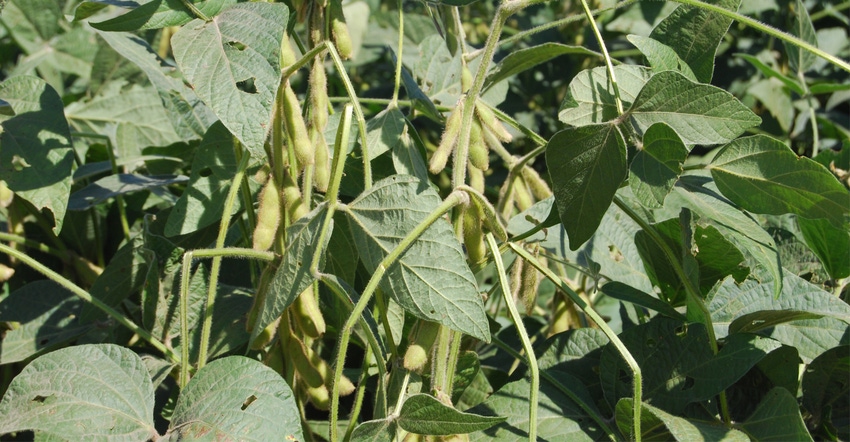October 30, 2018

Soybean yields were all over the place in 2018, which isn’t unusual. But what caught some folks attention was the wider-than-usual range between highs and lows in some cases. Whether it was within fields, between fields or from different areas altogether, this year is generating more questions and comments about yield variability than usual.
Given the wide range of weather farmers faced from spring through harvest, maybe this isn’t a surprise since weather is the biggest wild card of all the factors driving soybean yields. But weather differences don’t always explain some of the yield variability. We don’t have a lot of say in what Mother Nature sends our way, but we can mitigate it to a degree by matching genetics to the environments we expect.
We have a much greater degree of control with the two other major factors that drive yield: genetic selection and management. In some of the yield variability situations, these two helped account for the variability beyond weather. Since we’re heading into the time of year for nailing down seed orders, let’s talk about selecting the best genetics for our fields to maximize returns and minimize variability.
Where do we start?
While thinking about how to approach seed selection from a different angle, I had this brilliant idea. Instead of how I’ve always approached seed selection, the traditional farm or office visit between seed dealer and customer, why not join the technology age with this task, too?
So, I started with the online seed selection tools from four companies and got initial recommendations for my area. Like so many other brilliant ideas, this started heading south on me quickly; there were about 100 varieties to pick from. We’ve got to trim that down to a manageable number, so what are our priorities?
You might say, “What do you mean, ‘Where do we start?’ ” Our priority is yield!” You nailed it; yield potential is priority No. 1, but how do we know how much these bean varieties will yield for us?
While there were a lot of agronomic choices in most of the online seed selection tools I could use to narrow the field down from the initial 100 varieties, “yield potential” wasn’t one of them. The sites had links to yield data, so that was helpful. But with nearly a third of the varieties being new for 2019, yield data on those is harder to find.
Local and regional test plot results can be useful in getting info on new varieties. Some farmers share yield data on their varieties with neighbors or local groups. Occasionally, there can be some limited data on new varieties in yield information exchanges like these if somebody had access to the variety a year ahead of a full release or raised seed beans for a company.
While yield info from seed companies and fellow farmers is helpful, the bottom line is the sheer number of varieties on the market — along with their shorter life cycles — make it tough to find a lot of multiyear, multi-location yield data. Since many seed experts point out that the most accurate prediction of a variety’s performance is a stable yield in many locations over several years, it looks like we need sources for more data!
Two more places to find yield data are Iowa State University’s own Iowa Crop Improvement Tests at croptesting.iastate.edu and the Farmers Independent Research of Seed Technologies at firstseedtests.com.
Between the two programs, regional yield data is available for hundreds of soybean varieties, across many locations and a fair amount of it multiyear. With multiyear data for new genetics hard to come by, the best alternative is to look at the one-year results from the Iowa Crop Performance Test and other sources where there are replicated trials from numerous locations.
Next steps to take
We can increase our odds of getting higher yields by matching soybean agronomic traits to our particular soils and production systems. Luckily, the seed companies made sorting varieties out by agronomic traits a lot easier than trying to figure out yield potential. Some of the ratings are subjective and it isn’t always easy to compare different companies since their terminology and ratings scales may vary, but it is worth the effort.
As we start sorting through varieties and comparing them, any guesses as to the most important agronomic trait to consider? If you answer, “resistance to soybean cyst nematode,” you are right; approximately 75% of Iowa fields have SCN.
Not too many years ago, if we suspected or knew we had SCN, management was simple: Plant resistant genetics. Now it is more complex because nematode levels could be building up and you may be losing yield even with SCN-resistant beans.
Resistance to SCN in soybeans is provided by several genes, and not every resistant soybean variety receives all of the resistance genes during the breeding process, even if they’re bred from the same resistance source, such as PI 88788. Consequently, not all SCN-resistant soybean varieties provide the same level of nematode control.
You must look at both yield potential and how effective the resistance is of the SCN-resistant soybeans you are considering. Thanks to funding by the soybean checkoff through the Iowa Soybean Association, ISU annually evaluates nematode control and yield of SCN-resistant varieties in numerous field experiments conducted in SCN-infested fields.
Making effective SCN management even more important are the interactions between common diseases like brown stem rot and sudden death syndrome (SDS) and SCN. It’s complicated, but the short version is when they hit soybean fields that also have SCN, disease symptoms occur earlier, are more severe and yield losses are higher.
Next level of sorting
If you have a good idea of the disease history in your fields going to soybeans, your ability to match the best genetics to your situation (and narrow the online lists some more) just went up significantly. While gene-specific resistance to pathogens like SDS and white mold is still a work in progress, if we have a likelihood of facing those diseases, we should look at varieties the seed companies give good ratings for fighting these diseases.
While the scoring isn’t an exact science, comparing seed company ratings with past years’ agronomic observations of the same or genetically similar varieties over a wide geographic area can help you ground-truth disease resistance scores.
Another disease to check scores for is phytophthora, which depending on the season ranks just a notch or two below SCN and SDS in terms of yield loss to Iowa soybean growers. Most varieties have phytophthora resistance genes on board, and most are also rated for their natural or “field” resistance.
With different sets of resistance genes being used, some choices can be made with those. But unless you have a solid idea of what genes are or are not working in your situation, this is where your local seed adviser can help choose varieties that combine good resistance genes with field tolerance of� phytophthora.
Other factors to consider
The list of agronomic traits we can sort through keeps getting longer, but it helps shorten up my list of nearly 100 varieties. A lot of companies give scores for emergence, what types of tillage each variety is suited for, standability, iron chlorosis, plant height and a collection of other characteristics that can be helpful for variety selection in some situations.
The last category I’ll mention is herbicide resistance traits. It might be the most confusing, so it is worthy of another article. A fairly safe, general theme with those traits is that once you settle on the varieties that fit your agronomic needs, line up some time to talk with your chemical supplier. The approval status of various components of some of the systems is in flux, and rules and labels can be confusing to say the least.
Speaking of input suppliers, after giving the online seed selection tools a shot, the old way is still my preference. No doubt there are folks who prefer online tools for the entire seed selection process. For others, online variety and yield data is a good place to start, but it’s hard to beat the insight and service that local dealers provide when it’s time to finalize orders.
Good luck wrapping up harvest, be safe and enjoy the upcoming holidays!
McGrath is the on-farm research and Extension coordinator for the Iowa Soybean Research Center at ISU. Contact him at [email protected].
About the Author(s)
You May Also Like






